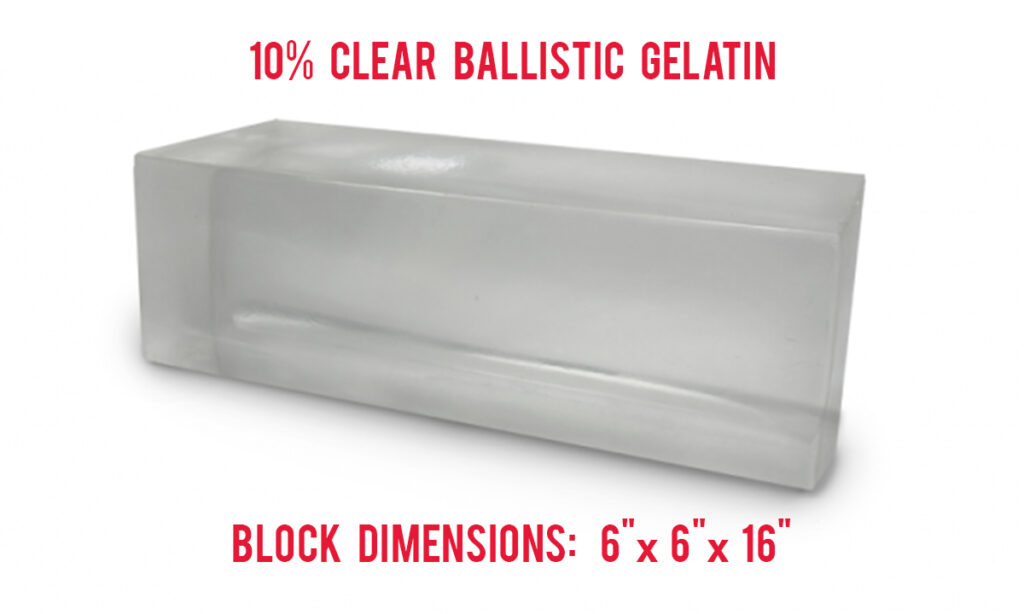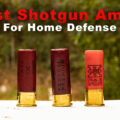As well prepared as you think you are, if you’re shooting the wrong ammo you may be giving an attacker a leg-up without even knowing it. Barriers can wreak havoc on a bullet that’s traveling through the air toward your target. Do you know how your self defense ammo stack up against some of the toughest intermediate barriers?
Intro to Ballistic Testing
We recently wrapped up our self defense ammo gel test project. To-date we have tested over 100 brands of hollow point ammo, across eight of the top calibers on the market today. With the data we were able to analyze penetration depth, expanded diameter and even weight retention against a set of performance standards used by the FBI.
As a follow up to our original project, we wanted to show you a glimpse into what happens when hollow points are fired through five of the remaining intermediate barrier tests. To summarize our findings, when the barriers get tough, ballistic performance of handgun ammo can get ugly.
You can jump straight to the barrier test results by clicking the links below:
- Bare Gelatin Ballistic Results
- Heavy Clothing Ballistic Results
- Drywall Ballistic Results
- Plywood Ballistic Results
- Sheetmetal Ballistic Results
- Laminated Glass (Windshield) Ballistic Results
Taking A Closer Look At Bullet Performance
For the beginners out there, there are a ton of different types of handgun ammunition. Of course, the two most popular categories are Full Metal Jacket (FMJ) ammo and Hollow Point (HP) ammo.
FMJ ammunition is typically a lead bullet encased by a harder metal. Since FMJ ammo doesn’t typically deform when encountering a barrier, over penetration frequently occurs. This can potentially cause injury to others beyond the target. The bullet creates more damage than intended. For this reason, FMJ ammo is typically not a good choice for personal or home defense.
Hollow Point ammunition on the other hand is pretty much what it sounds like. The projectile is designed with a hollowed out center tip. When an HP projectile impacts a target, the hollow cavity causes the bullet to deform, expand or “mushroom”. The expansion of a HP bullet creates a larger wound channel, leaving devastating effects. This is what makes the HP round an ideal choice for self defense purposes.
In real world defense situations you may find yourself dealing with a number of different barriers between you and a threat. This long list can be things such as other vehicles, clothing, glass and a number of other obstacles that can alter the performance of a bullet.
While you can expect to see a decline in bullet performance when testing with heavy barriers such as wallboard and glass, a soft cloth barrier can sometimes hinder performance of a projectile just as much. Clothing materials tend to cause real problems clogging up the hollow tip of some brands of ammunition. This prevents the round from expanding. A smaller diameter round means a smaller wound channel in your target.
Terminal Ballistics
Whichever brand and caliber of ammo you trust your life with, it needs to successfully perform in these three areas:
- Penetration
- Expansion
- Weight Retention
Penetration, expansion, and weight retention are three factors you should understand. While you don’t necessarily need ideal performance in all three categories to successfully stop a threat, understanding how potential barriers influence these performance categories will only give you a leg-up if find yourself in a life threatening situation.
A round needs to successfully penetrate intermediate barriers to successfully stop a threat. Ideal expansion of a hollow point is desired to cause greater internal damage, leading to effective blood loss and incapacitation. Self defense projectiles that hold their weight when penetrating barriers will retain the overall energy of the round.
Ideal penetration as defined by the FBI is 12-18 inches into the ballistic gelatin. This range translates to reliable bullet performance to affect vital organs within a human target despite mitigating factors, such as angle of impact or other intermediate barriers.
Successful expansion is typically measured as 1.5 times the original diameter of the projectile. For example, a 9mm bullet is .35″ in diameter. A minimum expanded diameter of .525″ would be considered an ideal measurement.
The weight retention capabilities of a self defense round can help a bullet achieve outstanding performance or fail completely. If a projectile breaks apart upon impact to a target the loss of weight that occurs can result in a corresponding loss of power.
Although, there can be an exception to this rule. Fragmenting ammunition designed specifically to create a larger wound channel doesn’t need to retain its weight to create devastating wounds. These fragmenting rounds are usually seen more in military rifle and varmint hunting applications.
Cover vs. Concealment
In a home or personal defense situation, you can’t expect to always have ideal shooting conditions. Clear shots from five to 10 yards, while ideal, aren’t always an option during a life threatening situation. You will need to make split second decisions about shot placement when defending your family or yourself in your home or automobile.
Walls, doors, and even vehicles can come between you and an attacker in the real world. That building wall or car door you might find yourself hiding behind during a fight might not do you any good if the bad guy’s ammo can effectively penetrate it. Understanding how these barriers affect bullet performance could keep you safe and aid you in eliminating a threat.
FBI Ammo Testing Standard
In 1986, the Federal Bureau of Investigation wanted to better understand the ammunition their agents were using following a deadly shootout between agents and two serial bank robbers. After years of research, the FBI created a set of standards for testing potential duty ammunition. This standard is now looked at as one of the most comprehensive tests for HP ammunition.

The FBI test protocol runs through a full cycle of eight test events. Each event is designed to test a HP bullet by shooting the ammo through intermediate barriers such as drywall, steel, and auto glass before penetrating ballistic gelatin. The ammunition is then tested for velocity and accuracy.
We deviated slightly from the strict FBI guidelines in our initial testing, so that our results might reflect more of what a civilian may encounter in a self defense situation. Also for the sake of brevity, we only focused on one of the eight test events in which the ammunition penetrates a heavy clothing barrier prior to impacting the ballistic gelatin.
Testing New Intermediate Barriers
For this next round of ballistic testing we will be testing and analyzing five new barrier setups, in addition to the results of the heavy clothing barrier test for our selected ammunition.
- Bare Gelatin
- Heavy Clothing
- Drywall
- Plywood
- Sheetmetal
According to the FBI, the results of testing with these barriers are an assessment of a bullet’s ability to inflict effective wounds after defeating various intervening obstacles commonly present in law enforcement shootings.
Ammunition Tested
We chose two 9mm and two 45 ACP brands of HP ammo for this project. The 9mm rounds were test fired using a Smith & Wesson M&P Shield with a 3.1″ barrel. The 45 ACP rounds were test fired using a Ruger SR45 with a 4.5″ barrel.
1. 9mm Winchester W Train and Defend 147gr. JHP
This particular load is from the Defend series with a JHP projectile. These rounds are bonded for “maximum threat-stopping power” in personal defense situations, according to Winchester.
Average Muzzle Velocity: 890 FPS
2. 9mm Winchester Supreme Elite 147gr. Bonded PDX1 HP
The Bonded PDX1 is engineered to maximize terminal ballistics. The proprietary bonding process welds lead and jacket together to work as a unit controlling expansion and providing superior retained weight. The jacket has been notched into six segments to help promote positive, consistent and programmed expansion at a variety of impact velocities.
Average Muzzle Velocity: 889 FPS
3. 45 ACP Federal LE Tactical Bonded 230gr. +P HP
Each round is loaded with a 230 grain bonded hollow point projectile. These hollow points are specially bonded to deliver maximum weight retention, reliable expansion, and produce impressive barrier penetration.
Average Muzzle Velocity: 822 FPS
4. 45 ACP Federal LE Tactical HST 230gr. JHP
The Tactical HST Hollow Point Ammo offers consistent expansion and optimum penetration for terminal performance. This jacketed hollow point is designed to not plug while passing through a variety of barriers and also holds its jacket in the toughest conditions.
Average Muzzle Velocity: 856 FPS
According to Larry Head, senior manager of ammunition product development at Federal Premium, “The HST was developed specifically to meet performance requirements, such as FBI protocols that many police departments and government agencies were requesting—specifically to get larger expanded diameters without sacrificing penetration.”
Expectations and Observations
Bare Gelatin
The FBI uses what’s called 10% Ordnance Gel as their test medium. It is made of organic material, and is a massive hassle to deal with when testing ammunition. Storing the blocks for long periods of time can be difficult unless you have a commercial size refrigerator on hand. The blocks are also very opaque, making it difficult to measure the damaging effects of the hollow point projectiles.
To avoid those hassles and to have the ability to scale our project we used 10% clear ballistic gelatin material from Clear Ballistics to simulate living tissue. Each block used was six inches square by 16 inches long. Clear Ballistics calibrated each block prior to our testing.
The bare gelatin for this round is less of an actual barrier and more of baseline of what to expect from the ammunition being tested. It can also be used to see what type of performance is needed to defeat other body parts that are in the path of a threat’s vital zones.
These are the kind of results you generally want to see when shopping for self defense ammo. All test rounds performed as intended, per their design. We saw good expansion, successful penetration, and ideal weight retention across the board.
Let’s consider this the baseline and move forward with some barriers.
Heavy Clothing
This round of barrier testing is the standard we used for our Self Defense Ballistic Test. The Heavy Clothing barrier test is designed to show how a HP projectile will perform when encountering a subject wearing typical cold-weather gear.
Here we are using materials that mimic wearing a cotton T-shirt, cotton dress shirt, a layer of fleece and a layer of denim. We can assume that if the hollow point round performs well through all four layers of heavy clothing, that it would also have similar or even better results when fewer layers of clothing are present.
While clothing might not seem like an issue for ammunition, some hollow points have the tendency to get “clogged up” leading to a failure in expansion. The issue comes from the tip of the hollow point becoming so packed with fabric material that it cannot successfully initiate expansion. Without expansion, the terminal ballistic performance is reduced, resulting in the chance of over penetration.
With advances in technology, many ammo companies have attempted to remedy this issue by designing their rounds to successfully expand even through thick barriers.
The thick clothing barrier did not plug up any of our test rounds. However, the barrier caused the 45 ACP rounds to penetrate farther than they did in the bare gelatin. This could be caused by delayed expansion after defeating the clothing barrier.For the most part, we saw similar performance, compared to testing with bare gelatin.
Overall, penetration, expansion, and weight retention all fall into acceptable ranges, except for the 9mm Winchester PDX1 Defender rounds. Coming in at 20.7″, these rounds penetrate just over the FBI recommended 12-18″ penetration mark.
Although speculative, these PDX1 rounds could technically over penetrate in a self defense situation if the attacker was wearing similar or lighter weight clothing.
Drywall
In many home defense situations the homeowner may not have a clear view of his target due to the often small layout of hallways and rooms. While shooting through an interior wall may go against a basic firearm safety rule of “Know your target and what’s beyond it”, in a life threatening situation there may be no other choice.
Drywall isn’t the toughest of materials, but it still has the chance to hinder the performance of your self defense ammunition.
The wallboard barrier test requires two pieces of half-inch drywall set 3.5 inches apart. This round of testing simulates a HP round traveling through a typical interior wall of a home.
The 9mm rounds consistently failed to expand after impacting the drywall board. The drywall essentially compacted and clogged the hollow point tip, preventing expansion. The failure to expand likely contributed to the increased penetration depth of the 9mm rounds. These clogged rounds could easily over penetrate a target in a home defense shooting situation.This round of testing is where we start to see a degradation in performance from some of our test rounds, specifically 9mm.
On the other hand, the heavier 45 ACP rounds successfully defeated the drywall board and performed well across all three ballistic categories. This is in large part due to the extra mass and energy exerted by the heavier grain projectiles.
Plywood
This round of barrier testing calls for a single .75” thick piece of plywood. It is designed to simulate shooting through a wood door or thin exterior wall.
Thick wood barriers are one of the hardest barriers to shoot through and still see good performance from a HP projectile. The fibers from the wood, like the drywall board, tend to clog the HP preventing expansion.
The 45ACp rounds actually penetrated farther than previously seen, largely in part to their lack of expansion. The lack of surface mass of the non-expanded projectiles allowed them to penetrate farther into the gelatin.Now we start to see a barrier that causes deterioration in both 9mm and 45ACP performance. The wood fibers clogged the HP upon impact, preventing the rounds from expanding almost all together, while affecting penetration depth. The 9mm rounds were slowed down significantly after penetrating the board, decreasing the penetration depth.
For both calibers, the projectiles that did successfully expand were most likely the ones that traveled through already weakened areas of the plywood board. In a real world situation, it’s probably not smart to anticipate follow up shots that travel through the same area.
You can expect to see poor performance from any HP that is being fired through an exterior wall of a home or building.
Sheet Metal
Hiding behind a car door like you see in the movies doesn’t necessarily afford you the protection against an armed attacker as you might think. Automobile doors and much of the entire vehicle’s exterior is simply thin steel or aluminum wrapped around a metal frame.
With terrorists utilizing vehicles as a means to harm a large number of people in recent years it’s not uncommon, especially for law enforcement officers, to be in a situation where shooting through an automobile door may be one of the only options to stop a threat.
The sheet metal test utilizes two pieces of 20-gauge steel set 3 inches apart, simulating an automobile door. For the most part, hollow point rounds shouldn’t have any issue actually penetrating an automobile door, it’s what the steel does to the projectiles during impact that can create expansion issues.
Although you don’t see ideal expansion in either caliber, these rounds still have potential deadly affects on a target based on the penetration data.As expected, impacting the steel plates caused the HP to deform in a way that prevents the bullet from expanding. Each projectile basically turned into a large hole punch.
45ACP has the tendency to over penetrate in this category, again due to the energy of the larger grain projectiles.
Laminated Glass or Windshield
The auto glass barrier test is one of the most punishing tests for ammo there is. Here we test fired rounds through 0.25-inch laminated glass placed at an angle of 45 degrees. Continuing our look at automobiles as barriers, the laminated glass test simulates shooting through a vehicle windshield.
While laminated glass in not the only window in a vehicle, it is the definitely the hardest to shoot through. Side and rear windows are typically made from tempered glass, which tend to shatter easier than a laminated windshield.
Due to potential trajectory change, poor follow up shout placement and other uncontrollable factors shooting into or from an automobile should be only be considered during a worst case scenario.
Penetration depth for both calibers suffered, but still fall into somewhat acceptable ranges. Any formal expansion is really nonexistent and the projectile tends to lose a significant amount of original grain weight.Almost any round you shoot through a windshield will become a mangled wad of lead. Although, the bullet can deform in such a way that it can still do plenty of damage to a target.
Jacketed hollow point ammo and auto glass don’t get along well. The thick laminated glass has the tendency to completely rip away the metal jacket from lead bullet. This can cause a severe decrease in performance. Once apart from the jacket, the lead bullet can change trajectory and potentially miss your target all together. This can be observed from one of 45ACP Federal HST test rounds.
Things to Remember
Intermediate barriers can come in all shapes and sizes. Cars, buildings, and clothing can all affect the way your self defense ammunition performs. When shopping for ammunition, keep in mind the types of situations you might find yourself in. There’s no “one size fits all” solution when it comes to personal defense, so find what work best for you.
And while again this wasn’t a test to pit 9mm and 45ACP against each other, there may be some value to the “bigger is better” idea when it comes to using certain calibers in some shooting situations. In multiple areas 45ACP did outperform 9mm due to its greater mass and energy. Just something else to keep in mind for your personal needs.






















